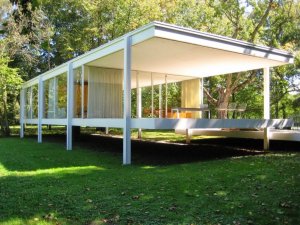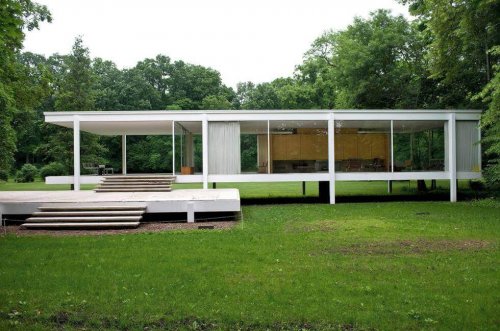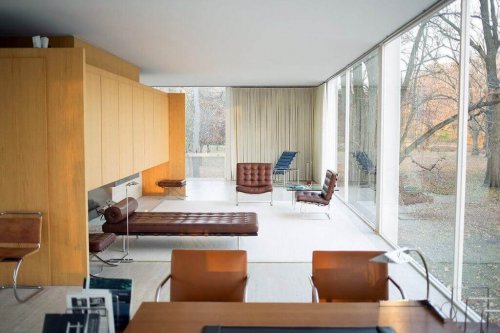The Farnsworth House - a Basic and Functional Structure

If you want to discover great works of architecture, you must read about the Farnsworth House – a basic and functional structure. This construction brings together different modern resources, typical of the aesthetic advances of the twentieth century.
In the past, various artistic procedures were developed to create new tendencies and paradigms.
The audacity of many artists has allowed us to discover new interior design options. In this case, the interior decoration reflects a groundbreaking and simple style at the same time.
When was it built and by whom?

The Farnsworth House was built by Ludwig Mies van der Rohe between 1945 and 1951 in Plano, Illinois. Many people visit it every year and it has become a tourist landmark.
It’s a detached house, situated in nature, on the banks of the Fox River. The purpose was to combine different design concepts to achieve a different type of home. In other words, an alternative.
This architect’s creativity allows us to now enjoy this amazing and functional construction. There’s no doubt that Ludwig Mies van der Rohe opened a door to new prospects for interior design.
“Architecture is the will of the epoch translated into space.”
-Ludwig Mies van der Rohe-
What you can see from the outside
The basic structure of the house is a very elongated rectangle, supported by pillars that rise from the ground and keep it in the air. It’s a simple and basic structure, but with very interesting formal content.
- The house itself contrasts with nature due to its white color. The framework of the house is white, which is why the architect wanted to ensure freshness and purity from the outside.
- The house has peculiar access – stairs that ascend into a platform that allows you to go inside. The architect made this access to invite people to come inside.
- The porch is quite large and opens the house to the exterior and makes contact with nature.
The striking interior of the Farnsworth House

Once you access the inside, you see that the house is an open space. Although it’s rectangular, it doesn’t feel narrow.
- There’s ample space and the house doesn’t have a lot of decoration. Nothing should disrupt the tenant, who can wander inside, as the house only comes with the necessary and essential furniture.
- The house makes the tenant open up to the exterior. Nevertheless, they’ll be able to hide the things they don’t want on show. To do this, there’s a central wooden frame for privacy.
- Perhaps one of the most important characteristics of this house is its connection to the exterior through its windows. This way, you can see the home’s internal life and have immediate contact with nature.
- The architect did this to merge architecture and the exterior. Thus, it doesn’t seek privacy. On the contrary, it’s a dynamic and very simple work of art.
With few resources, you can make great things.
The refinement of architecture

Architects can build different types of constructions. The interior design of this home shows that you don’t need a lot of furniture to fill up empty spaces. Instead, the empty spaces must communicate with the furniture.
The house itself is a thorough study of measurements that tries to achieve harmony in all its parts. The interior decoration goes well with the external decoration, which achieves a principle of proportionality.
The structure is consolidated and, finally, there’s a direct relationship between all its parts, both internal and external. Undoubtedly, we’re talking about a functional construction that’s an example of the International Style.
https://midecoracion.com/casas/la-casa-farnsworth-una-estructura-basica-y-funcional/
If you want to discover great works of architecture, you must read about the Farnsworth House – a basic and functional structure. This construction brings together different modern resources, typical of the aesthetic advances of the twentieth century.
In the past, various artistic procedures were developed to create new tendencies and paradigms.
The audacity of many artists has allowed us to discover new interior design options. In this case, the interior decoration reflects a groundbreaking and simple style at the same time.
When was it built and by whom?

The Farnsworth House was built by Ludwig Mies van der Rohe between 1945 and 1951 in Plano, Illinois. Many people visit it every year and it has become a tourist landmark.
It’s a detached house, situated in nature, on the banks of the Fox River. The purpose was to combine different design concepts to achieve a different type of home. In other words, an alternative.
This architect’s creativity allows us to now enjoy this amazing and functional construction. There’s no doubt that Ludwig Mies van der Rohe opened a door to new prospects for interior design.
“Architecture is the will of the epoch translated into space.”
-Ludwig Mies van der Rohe-
What you can see from the outside
The basic structure of the house is a very elongated rectangle, supported by pillars that rise from the ground and keep it in the air. It’s a simple and basic structure, but with very interesting formal content.
- The house itself contrasts with nature due to its white color. The framework of the house is white, which is why the architect wanted to ensure freshness and purity from the outside.
- The house has peculiar access – stairs that ascend into a platform that allows you to go inside. The architect made this access to invite people to come inside.
- The porch is quite large and opens the house to the exterior and makes contact with nature.
The striking interior of the Farnsworth House

Once you access the inside, you see that the house is an open space. Although it’s rectangular, it doesn’t feel narrow.
- There’s ample space and the house doesn’t have a lot of decoration. Nothing should disrupt the tenant, who can wander inside, as the house only comes with the necessary and essential furniture.
- The house makes the tenant open up to the exterior. Nevertheless, they’ll be able to hide the things they don’t want on show. To do this, there’s a central wooden frame for privacy.
- Perhaps one of the most important characteristics of this house is its connection to the exterior through its windows. This way, you can see the home’s internal life and have immediate contact with nature.
- The architect did this to merge architecture and the exterior. Thus, it doesn’t seek privacy. On the contrary, it’s a dynamic and very simple work of art.
With few resources, you can make great things.
The refinement of architecture

Architects can build different types of constructions. The interior design of this home shows that you don’t need a lot of furniture to fill up empty spaces. Instead, the empty spaces must communicate with the furniture.
The house itself is a thorough study of measurements that tries to achieve harmony in all its parts. The interior decoration goes well with the external decoration, which achieves a principle of proportionality.
The structure is consolidated and, finally, there’s a direct relationship between all its parts, both internal and external. Undoubtedly, we’re talking about a functional construction that’s an example of the International Style.
https://midecoracion.com/casas/la-casa-farnsworth-una-estructura-basica-y-funcional/
All cited sources were thoroughly reviewed by our team to ensure their quality, reliability, currency, and validity. The bibliography of this article was considered reliable and of academic or scientific accuracy.
Cohen, Jean-Louis: Mies van der Rohe, París, Akal, 2007.
Dachs, Sandra; García Hintze, Laura; de Muga, Patricia: Mies van der Rohe: muebles y objetos, Barcelona, Polígrafa, 2010.







